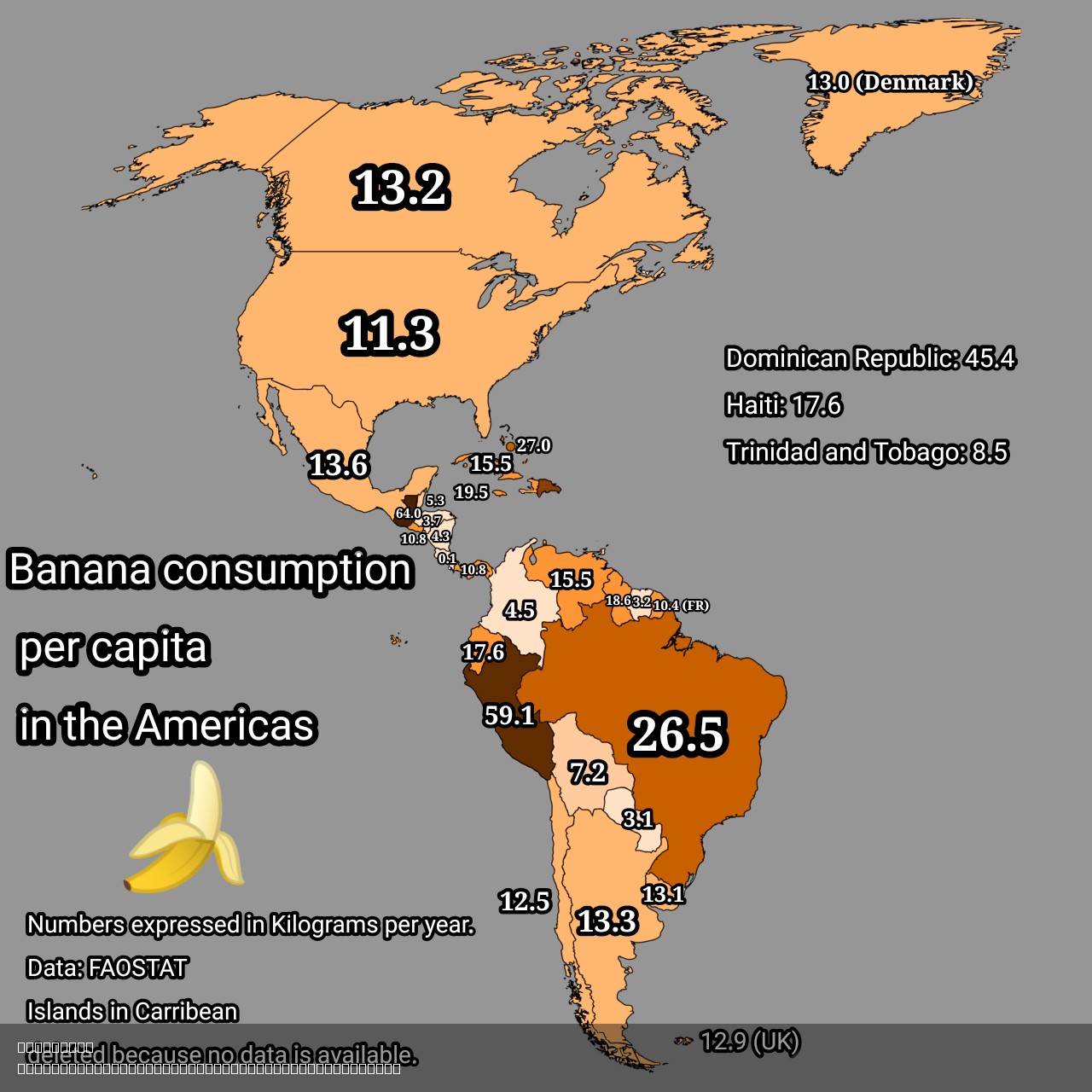Banana Consumption Per Capita in the Americas Map


Marcus Rodriguez
Historical Geography Expert
Marcus Rodriguez specializes in historical cartography and geographic data analysis. With a background in both history and geography, he brings unique...
Geographic Analysis
What This Map Shows
This map displays banana consumption per capita across various countries in the Americas, allowing us to visualize not only where bananas are most popular but also how cultural preferences, economic factors, and agricultural practices influence this beloved fruit's consumption. Bananas, as one of the most widely consumed fruits globally, hold special significance in the diets of many populations, particularly in tropical and subtropical regions. With this map, we can see the nuances of banana consumption across North America, Central America, and South America, revealing interesting trends and regional preferences.
Deep Dive into Banana Consumption
Banana consumption is not just a matter of taste; it reflects a complex interplay of agriculture, economics, and cultural practices. Interestingly, bananas are a staple food in many countries, particularly in the Caribbean and parts of Central America, where they are often consumed as a primary source of carbohydrates. According to the Food and Agriculture Organization (FAO), global banana consumption has seen a steady rise, with significant variations in per capita consumption among different regions.
In the Americas, the average person consumes several kilograms of bananas each year, with countries like Ecuador and Honduras leading the way. Ecuador, notably, is not only one of the largest consumers but also the world's largest exporter of bananas. The country’s climate and fertile soil create ideal conditions for banana cultivation, making it a vital part of the local economy and diet. Moreover, bananas serve as a dietary staple in many households, providing essential nutrients and energy.
What’s fascinating is how banana consumption patterns can vary so drastically even between neighboring countries. For instance, while Costa Rica enjoys high per capita consumption due to its local production and export industry, Mexico's consumption is comparatively lower, influenced by a more diverse fruit market and dietary habits. This highlights the importance of local agricultural practices and market availability in shaping dietary preferences.
As we delve deeper into the nutritional aspects, bananas stand out for their health benefits. Rich in potassium, vitamin C, and dietary fiber, they are often recommended as part of a balanced diet. The fruit's versatility also lends itself to various culinary uses, from breakfast smoothies to desserts, enhancing its appeal across different cultures.
Regional Analysis
When examining the map, we can categorize the Americas into three primary regions: North America, Central America, and South America, each with distinct banana consumption patterns.
In North America, particularly in the United States and Canada, banana consumption is high, largely driven by importation from Latin American countries. The U.S. alone imports millions of tons of bananas annually, making them one of the most popular fruits in American households. Interestingly, the preference for organic bananas has also risen in recent years, reflecting a broader trend towards health-conscious eating.
Central America showcases some of the highest per capita consumption rates, with countries like Honduras and Guatemala leading the pack. In these regions, bananas are often grown locally, making them more accessible and affordable. The cultural significance of bananas in these countries cannot be overstated; they are often featured in traditional dishes and celebrations.
In South America, Brazil and Ecuador stand out with notable consumption levels. Ecuador’s role as a banana exporter not only affects its economy but also its domestic consumption habits. What's intriguing is that while Ecuadorians consume a substantial amount of bananas, they also export vast quantities, indicating a robust agricultural sector. In contrast, Brazil's diverse agricultural landscape results in varied fruit consumption, including a strong preference for other tropical fruits like mangoes and papayas.
Significance and Impact
Understanding banana consumption patterns in the Americas offers valuable insights into agricultural trends, economic health, and dietary habits. As climate change continues to impact agricultural practices, monitoring banana production and consumption will become increasingly important. For instance, changing weather patterns could affect banana yields, leading to fluctuations in availability and prices.
Moreover, as we become more conscious of our food sources and their environmental impacts, the demand for sustainably produced bananas is likely to increase. This shift could influence not only consumption patterns but also how bananas are cultivated and marketed across the continent. Ever wondered how such changes will affect global food security? With bananas being a vital food source for millions, their cultivation and consumption will remain essential for both health and economic stability.
In conclusion, the map of banana consumption per capita in the Americas is not just a reflection of dietary preferences but a window into the region's agricultural practices, economic conditions, and cultural values. As we continue to monitor these trends, we can better appreciate the role bananas play in the lives of millions across the Americas.
Visualization Details
- Published
- August 6, 2025
- Views
- 156
Comments
Loading comments...